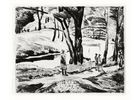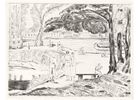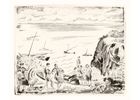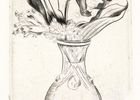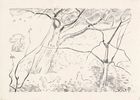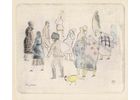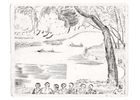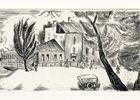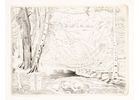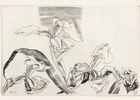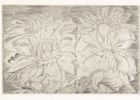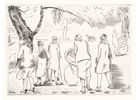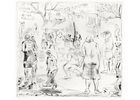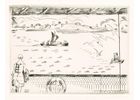Burin engraving
(German Stich, French gravure au burin) is
the oldest variety of engraving on metal. The engraver employs sharp burins to
apply a design to the surface of a metal (most often copper) plate. Then the burr is carefully removed
from the plate with a burnisher, and a roller is used to apply ink so that it
fills the grooves; next, the engraver carefully wipes the ink away from plane
areas and makes a print. To sum it up, burin engraving is a variety of
intaglio.
Burin engraving developed from the crafts of decorating metal objects with carvings practiced in bladesmithing and jewellery-making. In the Middle Ages the decoration techniques included filling out the lines grooved into the metal with coloured substances, most often niello. These patterns could be printed on paper or similar material, and the impressions thus produced were used by blade smiths, silversmiths and goldsmiths as references. Later, already in the first half of the 15th century, burin engraving gained acceptance: for a century anonymous ornament makers were bringing it to perfection, and already by the late 15th – early 16th centuries it reached the zenith in the works of such distinguished masters as Martin Schongauer and Albrecht D?rer in Germany, Antonio del Pollaiolo, Andrea Mantegna and Marcantonio Raimondi in Italy, Lucas van Leyden in the Netherlands. In the 17th, 18th, 19th centuries burin engraving gave way to etching, and only in the early 20th century it experienced a revival in the hands of graphic artists.
In Russia the
craft of burin engraving on metal started to be practiced in the 16th century,
in book decoration. In the 17th century it became more popular due to Ukrainian
engravers, but it was not before the age of Peter the Great that this craft
became truly wide spread – the examples include the engraved views of St. Petersburg
by Mikhail Makhaev and brothers Ivan and Alexey Zubov, the pieces produced by
combination of engraving and etching techniques by the portraitists such as
Yevgraf Chemesov and Gavrila Skorodumov. Later, the craft made way for other
techniques, first of all etching and lithography. In the 20th century the
artists Dmitry Mitrokhin and Georgy Vereisky brought burin engraving back to
life as a method for producing original prints.


